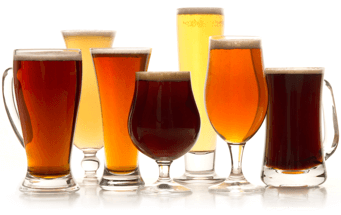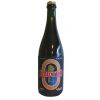Antares - Simpatico
-
ABV:
10%
The “Simpatico” name may sound familiar to you, assuming that you are at least about 30 years old and have been enjoying beer since the first days that you could (legally, of course). It is a brand that our company founded and marketed quite successfully in the 80s and 90s, and was most commonly recognized by its distinctive black bottle. If one concern creeps into your recollection – that it was a Mexican lager – the good news is that you can leave that thought packed away in the same shoebox as your Tone Loc cassette. While we are proud to bring you this worthy tribute beer with the name that is best translated as meaning likeable, or “in harmony,” it is a dramatically more serious and sophisticated brew than its predecessor.
Produced by the respected Antares Brewery in Mar del Plata, Argentina – the seaside resort city approximately 4 hours south of Buenos Aires – this is a big and complex beer, to be sure. When I tasted a sample bottle with Michael Jackson in June of this year, we were surrounded by some highly experienced and esteemed Belgian beer professionals. They were, of course, expecting very little in terms of quality from any South American brew being shared by a North American while sitting at an Antwerp beer festival that was featuring the likes of Orval, Malheur, St. Bernardus, and Liefman’s. It was with great relief that I heard Michael, after his first sip, tell them that they needed to take a minute and pay attention to this beer, because it had an “awful lot going on”.
Giving it his usual careful attention and respectfully slow analysis, he noted its lovely rich copper color, and generous floral nose. He found the flavors to be syrupy, floral, and fruity, with a finish that just kept going. He was impressed at how easily it carried its 10% alcohol, and called it a very nice beer – one that he thought should proudly wear the Simpatico name based on the word’s definition. There’s no need at this point to go into great detail about his thoughts on the previous life of Simpatico, but suffice it to say that industrial yellow pilsner derivatives from south of the border in clear bottles ranked at the very top of his pet peeve list – so you can imagine that black frosted glass alone was not really enough to earn his respect some 20 years ago. Let’ s just say that it was nice to be able to redirect the conversation to the topic of how one actually defines a barley wine.
And that, like so many subjects of old world brew styles and categories, was one that Michael understood as well as anyone. Following here is an excerpt from a 1998 article that he wrote called Heavy gravity, man , and it captures the historical essence of our exchange.
I pray that the old-established beer- style Barley Wine survives. The designation does seem to be vanishing from many brewers’ ranges, perhaps the victim of its own quaintness. Similar brews, sometimes darker and more chocolaty, often less strong, and frequently on draught, are known as Winter Warmers or Old Ales (Britain has no fewer than 120 of the latter). On other occasions, the term “Strong Ale” is thought to suffice, particularly in the case of paler, drier brews. The terms overlap. Within the broad selection of strongish winter brews, a barley wine is usually at the upper end of the scale, between 6.0 and 12.0 per cent alcohol by volume, or even slightly more. Traditionally, it came in small, nip bottles as though to protect the drinker from excess. In the days before the strengths of beers appeared on labels, barley wine was the stuff of myth and legend. In those innocent times, the jazz musicians of my provincial youth were addicted to nothing more sinister. The ratio of potency to volume removed the risk of needing a loo mid-solo.
At about the time that Antares Brewing Company, producers of this month’s feature beer, opened their brewing operations in Mar del Plata in 1998, Michael Jackson had just visited Argentina in search of something truly delicioso from South America. He made his way to Patagonia, and visited two very small craft brewers there. As was Michael’ s style, it is always enlightening to understand the history and qualities of as many brewers in any region as possible, and in that spirit, here is his 1999 article about that trip.
Where South America slims to the shape of a leg, the creases behind its knee are the valleys of the Colorado and Negro rivers. The last long stretch of Argentina forms the shin, with the Andes mountains as the bone, and Chile as the calf. For more than 1,200 miles this far southern region of those two countries is known as Patagonia. The name is believed to be a Spanish rendition of “Big Foot,” from the huge warriors allegedly encountered by the 16th-century explorer Ferdinand Magellan.
English seamen said they saw giants with steaming heads and the faces of lions or dogs. Coleridge’s “Rhyme of the Ancient Mariner,” Swift’s giants in “Gulliver’s Travels,” Shakespeare’s monster Caliban, in “The Tempest,” and Poe’s Tsalalians are all said to have been inspired by tales from Patagonia. Darwin travelled there in search of the Origin of the Species; Butch Cassidy and the Sundance Kid sought sanctuary; so did a cocktail of nationalities, famously including the Welsh; Bruce Chatwin searched for a sloth as big as a bull; Paul Theroux wanted to ride steam trains. I went in search of beer.
From the Argentine capital, Buenos Aires, I took a two-hour flight to San Carlos de Bariloche, an Andean town less than 100 miles from the border with Chile. After World War II, German atomic scientists were brought to work in this remote terrain by President Peron. Later military dictators pursued prestige projects on nuclear power, but these vanities were largely abandoned with the coming of democracy in 1983. This sequence of events was the precursor to micro-brewing.
Dodging the Hotel Presidente Peron, and certainly the Hotel Islas Malvinas, I chose the benign-sounding Hotel Edelweiss, handy for the Hosteria Suiza and the Confiteria La Alpina. The town is now an “Alpine” ski resort, though its patrons might be equally at home in Aspen, Colorado... even more reason for micro-breweries.
Julio Migoya and Nicolas Silin, the latter of Russian origin, both worked for a company designing nuclear power plants until they saw the writing on the reactor. Browsing through a do-it-yourself magazine, Nicolas read an item about home-brewing and had “a crazy idea.” He discussed it with Julio at work, and a colleague from the United States told them about the pioneering book on the subject by the British writer the late Dave Line and the American magazine “Zymurgy .”
In 1989, they began to home-brew for “saccharific friends and their families,” initially making beer that was “awful - acidic and sulphuric.” In 1991, they left their jobs and obtained a licence to brew in rented premis- es adjoining Julio’s house. They cracked their malt in a cof fee-grinder , brewed in a cooking pot, clarified the beer in a swimming-pool filter, hand-bottled their product, and sold it locally, delivering by sledge in the winter. The bottles were rinsed in a domes- tic dishwasher.
By 1993. They had their first “tied house”: they were serving their beer, with sandwiches of the local smoked deer and wild boar, in an informal daytime pub in the living room of Julio’s house during the tourist season. “Time” was called when his children wanted their evening meal.
In 1997, they opened a purpose-built brewpub in premises adjoining a gift shop. The enterprise is called Cerveceria (“brewery”) Blest, after a local beauty spot.
The wooden building is owned by Bebe Guttierez Arana, a carpenter and furniture- builder , who also provided the chairs and tables. He is a partner in the gift-shop with Guillermo Estévez, who sells marmalades and jams made from local berries. Guillermo played scrum-half for St. Albans, which turns out to be a school in Buenos Aires.
Cerveceria Blest, set back from the road, against a mountain backdrop is six or seven miles west of the town-centre. Its sign bears the rubric, “honest beers and ales.”
The interior features a collection of beermats, drinking vessels and bottles. There are paintings and stained glass windows on brewing themes by Nicolas’ daughter Natalia, who is studying art in Buenos Aires. Julio’s wife Alicia manages the restaurant.
In the centre of the room is a brew- kettle with a capacity of 2.8 hectolitres. This smartly-fitted stainless-steel vessel, with a copper trim, was built by the principals, with the help of skilled engineers laid-off by the atomic power company .
The beers are served unfiltered. The basic brew, with a lightly hoppy fragrance and bitterness, is flowery and refreshing. It is identified as being a “Pilsen” type. The town name, rather than its adjective, is usually employed in Argentina. A second regular brew is a Bock, at a modest gravity of 1052, with a light but smooth maltiness and good bitter-chocolate flavors. A third tap offers varying styles. At the time of my visit, a Scotch Ale was on offer: sweetish, soft, lightly fruity and nutty.
It seems churlish to say that the beers were slightly thin in body, or modest in their hop character. The marvel is that such interesting brews should be made in such a remote part of a country where the bland national beers play second fiddle to wine.
The partners had not even tasted a Scotch Ale when they attempted to create their own. The same was true of an earlier Stout; my “Beer Companion” was their guide to style.
The brewery has its own well, housed in a structure like a small chapel. Malt was more of a problem. The partners had to go personally to persuade the chief executive of a maltings to supply them, and are still not especially secure in this arrangement. They built their own rotating roaster (a steel drum, on rollers over gas burners) to convert pale malt to crystal, Munich and black, matching the colors from photographs in a magazine. They are now considering adding a heating element to a cement-mixer .
The hops are grown only two hours’ drive away, in El Bolson, the principal area of cultivation in Argentina. I headed in that direction with my traveling companion Brad Page, a brewer from Colorado. Wild rasp- berries at the roadside gave way to thorn bushes and occasionally the reptilian branches of the “Chilean” pine (Araucaria) as the route rose among greenish granite mountains, plunging precipitously to tiny settlements of corrugated-iron houses.
As the road approached El Bolson, the mountainsides were lined with hop-poles of cypress and eucalyptus. Men with Andean- Indian faces and black gaucho hats were out with a tractor, thinning the shoots. The dozen hop gardens in the area grow about 100 hectares in total, all Cascades. The valley has its own pelletizing plant, where Brad was presented with a 20-kilo carton of hops. The label identified El Bolson as a “non-nuclear zone,” clearly a two-fingered gesture towards the atomic past of neighbouring Bariloche.
Being much more remote, El Bolson attracted members of the self-sufficiency movement in the 1960s. (The road ends there, close to the border with Chile; there is no route through the mountains.)
Juan-Carlos Bahlaj, of Ukrainian origin, had sold windows and doors, and clothing, in Buenos Aires, but is a man who likes to wander. He has traveled by camper-van all over the Americas and Europe, and has developed a taste for Belgian and German brews. Juan- Carlos read the British 1976 classic “Complete Book of Self Sufficiency ,” by John Seymour (published by DK). Of its 256 pages, the four on home-brewing caught his eye. In 1980, he moved to Patagonia, established a camp-site in El Bolson, and in 1984 started to brew for his guests and friends. In 1986, he took the precaution of obtaining a license. “The more people moved here, the greater the bureaucracy,” he sighs.
He has used a solar grill and a pizza oven to prepare his malts, and has over the years increased his brew-length from ten to 70 litres to 2.5 hectos, always in home-built systems. At his conservatory-like Cerveceria Artesanal El Bolson, he serves the beer au naturel, but there are also a filtered, pasteurized versions in the bottle.
The golden lager, called Blanca, was a little too fruity for the style, but the rest of his range was delicious. His black Negra was rich, rounded and coffeeish; his equally dark Rauchbier seemed only lightly smoky at first, then erupted in fragrant dryness; his Framboise was fresh, fruity and beautifully balanced; his Cereza a tingly sour-cherry beer; his iron-like, firm, Cassis the best example I have ever tasted of that style.
When he served roasted mountain lamb with sweet potatoes, I wanted to stay forever, but we had to get back to Baroliche to catch a plane. We arrived to be told that the bird had flown. “It was rescheduled,” said the man on the desk. “Why did no one tell us?” we protested. “That’s Patagonia,” he explained.
Published in print January, 1999 in Ale Street News

Unmatched Variety by style, brewery & country
Choose from Five different Beer Clubs offering unmatched variety by brewery,
country of origin, and beer style to suit your specific tastes.


